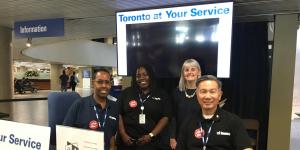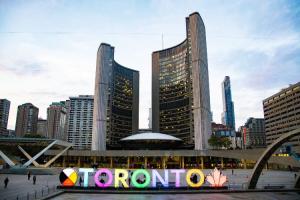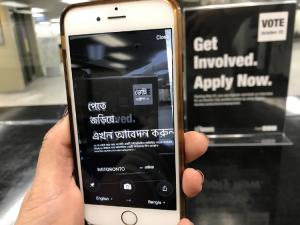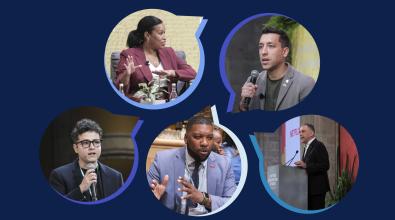How Toronto is rethinking the customer experience at City Hall

The two curvy towers of Toronto’s City Hall are an icon of modernist architecture and a draw for tourists who like to snap selfies by the illuminated TORONTO sign out front. But for anyone with city business to take care of inside, it can be easy to get lost in the buildings, and sometimes, the bureaucracy.
There are signs to guide people, to be sure. But whether they’re visiting to pay a bill or see their City Councillor, first-timers almost always do the same thing: They ask the security guards stationed in the lobby where to go.
From a customer service perspective, that’s not exactly ideal. The guards don’t always know the answers to people’s questions. And, in a city where more than 200 languages are spoken, they sometimes can’t communicate with visitors who don’t speak English. It also takes the guards away from the job they’re there to do.
Now, Canada’s largest city is experimenting with a solution. Since September, the information desk in the lobby of City Hall has been a sort of testing ground for new approaches to customer service. On the front lines of the effort are 311 operators — city staff who normally answer residents’ queries by phone or online, and now are deployed to handle the same job in person.
Two 311 operators are always present during business hours. One circulates the lobby with an iPad, seeking out people who appear lost or to be needing help, while the other minds the infodesk. They’re not just answering visitors’ questions, but also collecting data on foot traffic and trying out smartphone apps that can facilitate on-the-spot language translation. The new approach is handling as many as 400 requests per day, and has taken a load off the security guards. The number of non-security related questions they’re fielding has dropped by about half.
The idea in Toronto is simple yet powerful: to refashion the front door of local government so that the first interaction visitors have is warm, welcoming, and helpful. That can come as a surprise to some visitors at first, said Guhad Hersi, one of the 311 operators who’s been working lobby shifts.
“One man I approached thought I must be selling something,” Hersi said. “He’d never seen a government person come up and ask, ‘May I help you?’ We’re trying to break down that boundary people usually encounter in government settings, where there’s a glass wall dividing you. We’re making government more accessible.”
The experiment is part of a larger shift Toronto is making in its approach to customer experience. The city is not alone. The recently renovated City Hall lobby in Boston includes a welcome desk staffed with 311 greeters and kiosks to handle frequently requested services. And when Paducah, Ky., updated its City Hall last year, members of a new Customer Experience Department were stationed in the lobby to help people navigate city services.
Toronto is exploring taking services that are now scattered in different locations within City Hall or across the city and consolidating them at centralized hubs. John Doolittle, of the city’s Corporate Services Department, explained that putting 311 operators in the lobby was a way to test parts of that idea and generate learnings to inform development of that plan before investing in scaling it up at other city service centers.
“We saw an opportunity to get a quick win where we could immediately improve service to the public,” he said, “while at the same time gaining insight into what a broader hub model would look like.”
[Read: 7 ways to build a culture of innovation in City Hall]
Doolittle partnered with the city’s innovation team to develop ways of tracking data that will help with that rollout. In particular, they wanted to know what kinds of requests people would come to the infodesk with: Is it a service request like renewing a parking permit, an information request like learning about activities for seniors, or a simple wayfinding need like asking “Where’s the bathroom?”
They also wanted to know what languages visitors would most often need help in. That tapped directly into expertise the innovation team, or “i-team” for short, had been building for some time. While researching ways to create a more inclusive approach to civic engagement, the team found that language was a significant barrier between city staff and residents.
It was something they could experience right from their desks; the i-team’s offices sit in a highly visible location on the main floor of City Hall. Paula Kwan, who served as the team’s founding director until recently, recalls people tapping on the glass to get her attention and ask for help. For those who didn’t speak English, there was little she could do.
Kwan’s team began exploring how widely available apps like Google Translate and Microsoft Translator might break through the language barrier between city staff and residents. Using these free tools, Kwan could speak English into her phone and have the words come out in Mandarin, French, Korean, Tamil, Portugese, or dozens of other languages; it worked the opposite way as well.
While the apps can’t beat a live translator, “We see this solution as part of a portfolio of language tools the city offers,” Kwan said. “It makes initial contact and simple conversations possible.” The apps are also useful for translating written text, Kwan noted.
Kwan and her team of civic designers partnered with Doolittle’s operations team to test the translation tools and work them into the workflow of the staff working at the information desk. The apps are used as many as five times a day, Doolittle said. “That’s five people per day who would otherwise be wandering around aimlessly, feeling frustrated, not getting the service they need.” According to Kwan, the translation tools are a cost-effective and easy-to-use solution that other cities might want to consider. “What Toronto has learned from this can definitely be replicated and scaled to City Halls around the world,” she said.
There’s some irony in Toronto’s new approach. Since the city first launched its 311 line a decade ago, there’s been a relentless push to move government services and requests online. Going to City Hall to do those things was supposed to be a thing of the past. But many people still want to take care of business in person, for all sorts of reasons.
“It’s a lot cheaper to provide services online, but we’re not a business,” Doolittle said. “We’re here for everybody, and whether you’ve just arrived here as a refugee or lived here for 50 years and are simply used to coming in dealing with things in person, there’s no excuse for us to not provide you good customer service.”
Guhad Hersi agrees. He’s been working with Toronto’s 311 operation since its earliest says, and thinks there’s no end in sight to residents wanting to do some things face-to-face. “People are coming into City Hall with their smartphones, but they still want to speak to you,” Hersi said. “They’re still craving for that interaction because it’s refreshing.”



